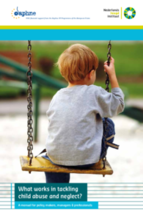The manual, What Works in Tackling Child Abuse and Neglect?, is the main outcome of the European Commission Daphne III programme, involving regional exchanges and research to bring together knowledge on what works in tackling child abuse. Five country reports (Germany, Hungary, Portugal, Sweden, and the Netherlands) were developed reviewing research findings and a comprehensive report compiled about strategies, measurements, and management of tackling the whole range of child abuse and neglect, from prevention to treatment. A study compiling practice-based knowledge on tackling abuse and neglect was also undertaken with parents and professionals in all five countries. Drawing from the evidence gathered through those processes, the manual aims to bridge the gap between international standards and recommendations on tackling violence against children and the evidence and practice-based knowledge regarding the quality of the systems, services, and professionals needed to tackle child abuse effectively. The manual provides specific conclusions and recommendations, and calls for the establishment of a sustainable care continuum for preventing and treating child abuse and neglect, embedded in a national framework.
One key recommendation is for governments to invest in both universal and targeted prevention strategies with proven effectiveness. A universal prevention strategy from Portugal (Rede Social), a targeted prevention strategy from Germany (German Federal Action Programme Early Prevention and Intervention for Parents and Children and Social Early Warning Systems), and a parenting support strategy from Sweden (The Swedish National Parenting Support Strategy) are introduced as examples of governmental strategies developed in regards to the prevention of child abuse and neglect and family strengthening. Part of the targeted prevention strategy includes a continuum of targeted parenting support interventions (Hermanns, 2011), which covers a range of supportive services for parents from light parenting support to home visits to parent education. One example of an effective evidence-based targeted approach is the Triple P Positive Parenting Programme. The program has been shown to be effective in the U.S., reducing the number of identified child maltreatment injuries and the number of children placed away from home, contributing to the overall well-being of children and their families.
Collectively, theses strategies point to the fact that prevention of child abuse and neglect not only reduces maltreatment of children, but also contributes to strengthening families. The project results show that universally accessible parenting programs as well as public media education program are effective in preventing child abuse. Effective targeted preventive programs support parents and teach them positive parenting skills. These services, in particular, need to be offered as early as possible. Programs providing and encouraging woman to seek proper parental and postnatal care show promise in preventing the maltreatment of children aged 0-3 years. Moreover, parenting information offered during pregnancy and immediately after the child’s birth can increase parents’ understanding of parenting, children’s needs and rights.
Interventions should be designed not only to stop the child abuse and neglect but also to change the home situation such that the child can grow up safely and with future prospects. Interventions should therefore be family-oriented and must at least partly take place in the child’s own community (‘home and community based’); Intervention should also focus on the parents. Primarily, the care and educational ability of the parents and the positive relationship with the children must be strengthened. In addition, services that seemed to be more likely to be successful at addressing families’ problems were those deliberately set out to engage with the trust of parents and children. When children are exposed to various lack of or inappropriate care, semi-residential services that provide comprehensive care, support and assistance most days of the week can compensate deficits.
The Manual also reviews the evidence on a range of out-of-home placement options available in cases where the safety of the child is at stake, in particular through foster care, the use of family centers and other forms of residential care. Research results suggest that caution must be taken in choosing suitable foster families, coaching them, providing placement stability for children with multiple placement changes, and resorting to residential care only for limited cases where such a setting is specifically appropriate and involves the best interest of the child.
©European Commission

